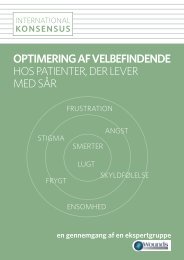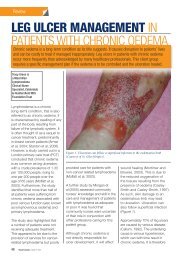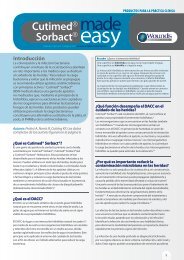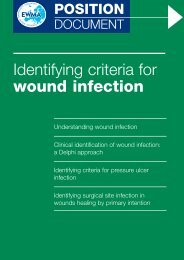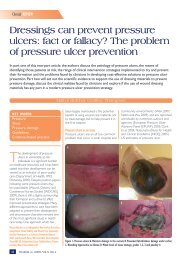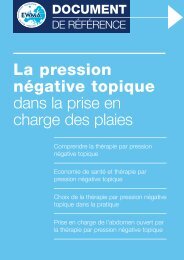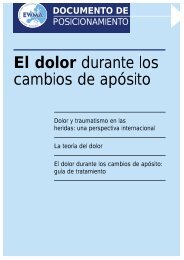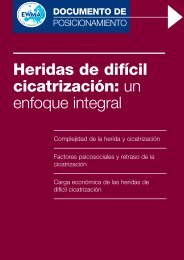リンパ浮腫管ç†ã® ベストプラクティス - 国際リンパ浮腫フレームワーク ...
リンパ浮腫管ç†ã® ベストプラクティス - 国際リンパ浮腫フレームワーク ...
リンパ浮腫管ç†ã® ベストプラクティス - 国際リンパ浮腫フレームワーク ...
Create successful ePaper yourself
Turn your PDF publications into a flip-book with our unique Google optimized e-Paper software.
international consensus13615242931323947484950505253
1-3 5 www.lf.cricp.org. ABPIIPCMLDMLLBSLDTBPI 3 4a Bc 1 2 2002 1 NHS 3 4 2 4 n n n 1 5 123456 1
6 7-10 11,12 6000 1 0.13-2% 13-15 12-60% 16-19 28-47% 20,21 1 ⁄ 4 14,22 n Dreyer G, Addiss D, Dreyer P, Norões J. Basic Lymphoedema Management. Hollis,USA: Hollis Publishing Company, 2002.n Dreyer G, Norões J, Figueredo-Silva J, Piessens WF. Pathogenesis of lymphaticdisease in Bancroftian filariasis: a clinical perspective. Parasitol Today 2000; 16(12):544-48.n Vaqas B, Ryan TJ. Lymphoedema: pathophysiology and management in resourcepoorsettings - relevance for lymphatic filariasis control programmes. Filaria J 2003;2(1): 4.n Global Alliance to Eliminate Lymphatic Filariasis www.filariasis.org.2
c 4 4n n n n n n n n n n n n n n n n n n n n n n n n n n n n n n n n n n 3
1 23 ■ ■ ■ ■ ■ ■ ■ ■ ■ ■ ■ ■ ■ ■ ■ ■ ■ ■ ■ ■ ■ ■ ■ ■ ■ ■ ■ 23 1 1 24 4
Figure 1 1c 5 6 7 5n n n n n n n n n n n 6n n n n 7n British Lymphology Societywww.lymphoedema.org/blsn Dutch Lymphoedema Networkwww.lymfoedeem.nln Lymph Network (Europe)www.lymphnetwork.comn Lymphoedema Association of Australiawww.lymphoedema.org.aun Lymphoedema Support Network (UK)www.lymphoedema.org/lsnn Lymphovenous Canadawww.lymphovenous-canada.can National Lymphedema Network (USA)www.lymphnet.org 5
ASSESSMENTc 8 9n 25 n 26 n 27 2 29 8n n n n n *n n n n n n n n n * 9n FBCn U&En TFTn LFTn n n ESR CCRPn B X n 28 6
ASSESSMENT(a)(b) 21 abn 29 n CT MRI 30 n 31 n Wuchereria bancrofti 3 n FOXC2 n VEGFR-3 n SOX18 11isl 6isl 0 isl 1 isl 2 isl 2 isl 3 108 LymCalc www.colibri.demon.co.uk International Society ofLymphology 11 7
ASSESSMENT 10 kgmBMIcm√ cmcmcm cmStemmer sign +/-+/- ABPI/TBPI +/-+/- mlmlmlmlmlml8
ASSESSMENT 10 MLLB 2 ml 10 2 cm 8-9 32,33 34 35 3 4 12 36 31 10
ASSESSMENT 3■ ■ * 2 cm †■ ■ 2 cm 4 cm ■ ■ ■ ■ ■ ■ * 2 cm †■ ■ ■ 2 cm4 cm ■ 2 cm 4 cm ■ ■ ■ ■ * † 3 4 4142 11
ASSESSMENT 4n n n 10 cm n 10 cm n n 2 cm n 10 cm n 10 cm ■ ■ ■ ■ ■ ■ ■ ■ ■ ■ ■ ■ ■ ■ ■ ■ ■ Stemmer sign 5 24-27 ABPI 8 MHz 4 MHz 37 ABPI 1.0-1.3 ABPI1.3 ABPI TBPI 38 12
ASSESSMENT 5stemmer sign2 abStemmersign (a)(b) 50 14 ■ ■ ■ ■ ■ ■ ■ ■ ■ ■ ■ ■ ■ ■ ■ 39 B 2 40,41 42 BMI BMI0.80 >0.90 44 3 3 45,46 80-87 cm32-34 88 cm35 94-101 cm37-39 102 cm40 13
ASSESSMENTc 7,10,47 n 13n n n n n 13 48NICE 2 ■ 1 ■ 1 14■ ■ ■ ■ ■ ■ ■ ■ ■ ■ ■ ■ ■ ■ ■ n n n n n n 14 WHO www.who.int/icidh/whodas 14
B B ■ ■ ■ ■ ■ MLLB MLDSLDIPC 6 15 15■ ■ ■ ■ ■ ■ ■ ■ ■ ■ ■ bulbous toes■ ■ ■ ■ ■ ■ ■ 3 ■ 3 ■ 15
6FIGURE 6n n 23 n n n n n n • • 15n n ISL I n n n n n n n n ISL II II n n n n n n n *n n n ISL II II III n n n n n n †n 17 n 19 MllB †n 17 n 19 †n 719 17-18 n 20 n n n n n n n * MLLB MLLB † 16
6■ ■ MLLB ■ ISL 1 39-45 SLD 4-6 3-6 3-6 MLLB ISL 2 2 MLLB MLLB 34 SLD ISL 2 2 3 MLLBMLD IPC MLD 719 2-4 49 >45 mmHgMLD MLLB >45 mmHgMLDMLLB DLT completedecongestive therapyCDT SLDIPC MLLB MLLB ■ ■ ■ 17
ABPI 0.5-0.8 25 mmHg 50 ABPI 0.5 >45 mmHgMLD SLD MLLB 1 3 15-25 mmHgSLDMLLB IPC 1 3 ■ ABPI 0.5-0.8 50 ABPI
7FIGURE 7aBPi 0.5-0.8*n n n n n n †n MLD SLDn MLLB>45 mmHg †n MLD SLDn MLLB>45 mmHg †n SLDn IPCn MLLB15-25 mmHg‡ †n MLLB– – – 35-45 mmHg 15-25 mmHg n IPC* ABPI
SLDMLLB MLLB ISL 2 2 MLLB MLLB 34 MLLB 2-4 MLD MLLB 1 1-3 ■ ■ ■ ■ ■ 8 MLLB MLD IPC 9 ■ ■ ■ ■ SLD■ MLLB ■ ■ 20
FIGURE 8 8 2-4 n n n 93 n n n n 9FIGURE 9n n n n creeping tissue refilln n n n n n n n n n * * * *n MLD SLDn MLLBn n MLD SLDn n n MLD SLDn n n MLD SLDn n IPC* 21
10MllB FIGURE 10■ ■ ■ ■ ■ SLD■ 10n n n n n n n aBPiaBPi0.8 MllB*45 mmHg IPCn n n n n n * 22
16 56 MLD SLD Lycra 25-30 mmHgMLD SLD MLD MLLB Lycra MLD SLD 16 ■ ■ ■ MLD SLD■ ■ MLD 23
B 11 12 17 17n n n n n n 17 11 12 1 2 24
13 14 15 16 13MLLB 1 14 Staphylococcus aureus 1 15 1 6 Whitefield 27-29 6 16- MLLB 17 181 17 18 25
19 20 21 22 19MLLB 2 20 26-8 ABPI 21 0.1% 3 7 0.05% 0.025ABPI
Stewart-Treves 23A ■ ■ ■ ■ ■ ■ DLA 24 1828 57■ ■ 48 ■ 1 2 23 24 27
18■ ■ ■ ■ ■ ■ Stewart-Treves ■ ■ ■ ■ ESR C CRP 4 NSAIDSLD MLD MLLD 4British lymphology society and lymphoedema support network 57 1 * *2**500 mg 8 +/-500 mg 6 †300 mg 6 300 mg 6 14 + iv 2 g8 iv1200-2400 mg6 iv5 mg/kg iv1.2 g 6 iv1.2 g 6 48 500 mg8 ■ 48 ■ ■ CRP
4 14 1-2 2 1 2 42 MLDSLDMlD slD cMlD MLDMLD MLD MLD 2,58-60 MLD MLD MLD MLD 19MLD MLD MLD SLD ( 20) MLD SLD 19MlD slDn n n n 29
MLD MLD ■ 1 ■ ■ ■ ■ ■ ■ ■ MLD 1 1 1 2 1 3 3 3 1 61 MLD MlD SLDMLD 62,63 20 SLDSLD MLD SLD MLD SLD SLD MLD 10-20 SLD ■ ■ SLD ■ ■ ■ ■ SLD slD 20MlD slD ■ ■ ■ ■ ■ ■ ■ *■ ■ ■ *MLD SLD 30
IPCIPCIPC IPC 30-120 3510 64,65 IPC IPC IPC SLD MLD 66 IPCIPC 21 21iPc n n n n n n n n n n n IPC IPC iPc ■ 30-60 mmHg ■ 20-30 mmHg■ 30 2 66-68 IPC IPC 69 IPC iPc 31
MLLB 22MllB ■ ■ ■ ■ ■ ■ ■ MLD MLLB B 70 MLLBMLLB 2534 MLLB MLLB ■ ■ ■ ■ ■ MLLB 22FIGURE 25 Resting and workingMLLB 23MLLB MLLB 5 MLLB■ ■ ■ ■ 23MllB ■ ABPI
MLLB 5MllB 1. 2. 3. 4. 'subcompressionwaddingbandage *5. * 6. 4681012 cm7. * Laplace 24■ ■ Laplace MLLB 7 MLLB 24laPlace 71P = T x N x 4630C x WP = mmHgT = kgfN = C = cmW cm 1 2-3 33
MLLBMLLB ■ ■ ■ ■ ■ MLLB ■ ■ ■ ■ ■ ■ ■ ■ MLLBMLLB MLLB MllB 25 26MLLB 26-33 2735-37 34-38 2837-38 25 72■ ■ ■ 1 ■ 34
MLLB 26MllB ■ ■ ■ ■ ■ ■ 5050■ ■ 8 ■ ■ 8 8 ■ ■ MLLB 26 27 MllB ■ ■ 4 cm ■ 10 cm20 cm■ 8 cm 1 10 cm 3-4 12 cm 4-6 27a4 cm 5 1 bcd(a)(b)(c)(d) 35
MLLB 28 (a)(b)(c) 29a8cm 5 1 b 8 c10 cm d(d)(a) (b) (c)(d) (e) (f) 30abc 2 3 d10 cm 12 cm e 1 8 f2 36
MLLB 31 MLLB 32 33 28 MllB ■ ■ 4 cm ■ 10 cm■ 6 cm 1 8 cm 1 10 cm 2-3 34 35a 4 cm 1 b 5 1 c d(a)(b)(c)(d) 37
MLLB 36abc 2 3 d(a)(b)(c)(d) 37a 6 cm 4 cm b 2 8 cm 10 cm1 c8 d10 cm 38 (a)(c)(b)(d)38
c 24 73 29 30 74 ■ 39■ 1 40 29■ ■ ■ ■ ■ ■ ■ ■ ■ 30■ ABPI36mmHg >49mmHg 39
39 40c 31 2 41 42 32 41-42 41 42 31■ ■ ■ ■ 32■ 2 ■ ■ ■ ■ ■ ■ ■ ■ ■ 40
FIGURE 39 Measurements for ready to wear compression garments for limbs.(a)(b) 2 cm† * * * † 41a 2 cm b 41
FIGURE 40 Measurements for custom made compression garments for limbs.(a)(b)G-H**HG-G1§G1G FC-GC-FE† D C-EC-DC* C1* Ca-Ga-Fa-Ea-Da-Ca-B1a-BaAGFEDCB1BHaE DCGFB12 cm2 cmB 2 cmH A †* C C 2 C1 C 3 cm † E E 1-2 cm E §E G G G § G-G1 **† G-H § 42ab42
33 33■ ■ ■ ■ ■ ■ ■ 34 353 6 ■ ■ ■ ■ 43 7 8 British Lymphology Society 34■ ■ ■ 35■ ■ ■ ■ ■ 43
FIGURE 43 41 73 73ABPIABPI0.8n ■ ■ ISL 0-2 ■ ■ ■ ■ ■ ■ n n ISL 2 -3 n *n n n n n n ISL 3 n *n n n n n n ISL 3 n *n ■ ■ ■ 14-21 mmHgn 23-32 mmHgn 34-46 mmHgn 49-70 Hgn n n n n n n †n n †n MLLBn ■ ■ * † 12 2 1 2 70 75 1 2 2 44
7 MLLB 2 Lycra ABPI
8 ■ ■ ■ ISL1-2 14-18 mmHg *■ ■ ■ ■ ■ ISL2 3 ■ 20-25 mmHg * ■ ■ ISL3 25-30 mmHg *■ 50-80* 25-30 mmHg46
76 77-79 36 36■ ■ ■ ■ ■ ■ ■ ■ ■ ■ 47
44FIGURE 42QOL QOL 44 3 48n n n n n n n n n n n n n n n n n n n n n n n 3 48 n n n n n 2 n 1 n 48
37 9 37■ ■ ■ ■ ■ 9■ ■ ■ MLLB■ ■ ■ ■ MLLB■ ■ IPC■ ■ ■ MLLB■ Lycra ■ ■ ■ SLD ■ Lycra 1 cm ■ ■ ■ SLD ■ MLD■ SLD ■ ■ ■ MLLB ■ ■ SLD ■ ■ ■ tubigrip 49
38 81-84,92-94■ ■ ■ ■ ■ ■ ■ ■ ■ 3 ■ ■ ■ 38 80,81 82 83-85 86,87 88 89,90 91 39 2 oxerutins 1,95 96 50
Oxerutins 95 97 79 98 X X 2 99,100 101 39■ ■ TENS■ ■ ■ ■ RECOMMENDED READINGn Badger C, Preston N, Seers K, Mortimer P. Benzo-pyrones for reducingand controlling lymphoedema of the limbs. Cochrane Database Syst Rev2004; 2: CD003140.n Badger C, Preston N, Seers K, Mortimer P. Physical therapies forreducing and controlling lymphoedema of the limbs. Cochrane DatabaseSyst Rev 2004; 4: CD003141.n Badger C, Seers K, Preston N, Mortimer P. Antibiotics/antiinflammatoriesfor reducing acute inflammatory episodes inlymphoedema of the limbs. Cochrane Database Syst Rev 2004; 2:CD003143.n Browse N, Burnand K, Mortimer P. Diseases of the Lymphatics. London:Arnold, 2003.n European Wound Management Association (EWMA). FocusDocument: Lymphoedema bandaging in practice. London: MEP Ltd,2005.n European Wound Management Association (EWMA). PositionDocument: Understanding compression therapy. London: MEP Ltd,2003.n Földi M, Földi E, Kubik S (eds). Textbook of Lymphology for Physiciansand Lymphedema Therapists. San Francisco: Urban and Fischer, 2003.n Lymphoedema Framework. Template for Practice: compression hosiery inlymphoedema. London: MEP Ltd, 2006.n Olszewski WL. Lymph Stasis: pathophysiology, diagnosis and treatment.Boca Raton: CRC Press, 1991. 51
APPENDIX 1 1British lymphologysociety ** † structured interaction3M Health CareActiva HealthcareBSN medicalHaddenham HealthcareHuntleigh HealthcareLohmann & RauscherMedi UKPaul HartmannSigvaris BritainSmith & Nephew HealthcareSSL InternationalVernon Carus 2leg ulcer advisory Board 50• ABPI• • ABPI 0.5-0.8ABPI
1. Badger C, Preston N, Seers K, Mortimer P. Benzo-pyrones forreducing and controlling lymphoedema of the limbs. CochraneDatabase Syst Rev 2004; 2: CD003140.2. Badger C, Preston N, Seers K, Mortimer P. Physical therapies forreducing and controlling lymphoedema of the limbs. CochraneDatabase Syst Rev 2004; 4: CD003141.3. Badger C, Seers K, Preston N, Mortimer P. Antibiotics/antiinflammatoriesfor reducing acute inflammatory episodes inlymphoedema of the limbs. Cochrane Database Syst Rev 2004;2: CD003143.4. Murphy MK, Black NA, Lamping DL, et al. Consensusdevelopment methods, and their use in clinical guidelinedevelopment. Health Technol Assess 1998; 2(3): i-iv, 1-88.5. Standards of Practice for Lymphoedema Services. LymphoedemaFramework Journal 2003; 1: 10-18.6. International Society of Lymphology. The diagnosis andtreatment of peripheral lymphedema. Consensus documentof the International Society of Lymphology. Lymphology 2003;36(2): 84-91.7. Tobin MB, Lacey HJ, Meyer L, Mortimer PS. The psychologicalmorbidity of breast cancer-related arm swelling. Cancer 1993;72(11): 3248-52.8. De Godoy JMP, Braile DM, de Fatima Godoy M, Longo O Jr.Quality of life and peripheral lymphedema. Lymphology 2002;35(2): 72-75.9. Williams AF, Moffatt CJ, Franks PJ. A phenomenological studyof the lived experiences of people with lymphoedema. Int JPalliat Nurs 2004; 10(6): 279-86.10. McWayne J, Heiney SP. Psychologic and social sequelae ofsecondary lymphedema: a review. Cancer 2005; 104(3): 457-66.11. Carroll D, Rose K. Treatment leads to significant improvement.Effect of conservative treatment on pain in lymphoedema. ProfNurse 1992; 8(1): 32-36.12. Mortimer PS. Managing lymphedema. Clin Exp Dermatol 1995;20(2): 98-106.13. Dale RF. The inheritance of primary lymphoedema. J Med Genet1985; 22(4): 274-78.14. Moffatt CJ, Franks PJ, Doherty D, et al. Lymphoedema: anunderestimated health problem. QJM 2003; 96: 731-38.15. Rabe E, Pannier-Fischer F, Bromen K, et al. Bonner Venenstudieder Deutschen Gesellschaft für Phlebologie. Phlebologie 2003;32: 1-14.16. Mortimer P, Bates D, Brassington H, et al. The prevalence of armoedema following treatment for breast cancer. QJM 1996; 89:377-80.17. Schrenk P, Reiger R, Shamiyeh A, Wayand W. Morbidityfollowing sentinel lymph node biopsy versus axillary lymph nodedissection fro patients with breast carcinoma. Cancer 2000;88(3): 608-14.18. Meric F, Buchholz TA, Mirza NQ, et al. Long-term complicationsassociated with breast-conservation surgery and radiotherapy.Ann Surg Oncol 2002; 9(6): 543-49.19. Ozaslan C, Kuru B. Lymphoedema after treatment of breastcancer. Am J Surg 2004; 187(1): 69-72.20. Hong JH, Tsai CS, Lai CH, et al. Postoperative low pelvic irradiationfor stage I-IIA cervical cancer patients with risk factors other thanpelvic lymph node metastasis. Int J Radiat Oncol Biol Phys 2002;53(5): 1284-90.21. Ryan M, Stainton MC, Slaytor EK, et al. Aetiology andprevalence of lower limb lymphoedema following treatment forgynaecological cancer. Aust N Z J Obstet Gynaecol 2003; 43(2):148-51.22. Hardy D, Taylor J. An audit of non-cancer-related lymphoedemain a hospice setting. Int J Palliat Nurs 1999; 5: 18, 20-27.23. Browse N, Burnand K, Mortimer P. Diseases of the Lymphatics.London: Arnold, 2003.24. Department of Health and Diabetes UK. Structured PatientEducation in Diabetes. Report from the Patient EducationWorking Group. London: Department of Health, 2005. Availableat: www.dh.gov.uk/publications (accessed August 2006).25. Mellor RH, Bush NL, Stanton AW, et al. Dual-frequencyultrasound examination of skin and subcutis thickness in breastcancer-related lymphedema. Breast J 2004; 10(6): 496-503.26. Wheatley DC, Wastie ML, Whitaker SC, et al.Lymphoscintigraphy and colour Doppler sonography in theassessment of leg oedema of unknown cause. Br J Radiol1996; 69: 1117-24.27. Burnand KG, McGuinness CL, Lagattolla NRF, et al. Value ofisotope lymphography in the diagnosis of lymphoedema of theleg. Br J Surg 2002; 89: 74-78.28. Bollinger A, Jäger K, Sgier F, Seglias J. Fluorescencemicrolymphography. Circulation 1981; 64(6): 1195-200.29. Partsch H, Stöberl Ch, Urbanek A, Wenzel-Hora BI. Clinical useof indirect lymphography in different forms of the leg edema.Lymphology 1988; 21(3): 152-60.30. Liu NF, Wang CG. The role of magnetic resonance imaging in thediagnosis of peripheral lymphatic disorders. Lymphology 1998;31(3): 119-27.31. Hayes S, Cornish B, Newman B. Comparison of methods todiagnose lymphoedema amongst breast cancer survivors:6-month follow-up. Breast Cancer Res Treat 2005; 89(3): 221-26.32. Kissin MW, Querci della Rovere G, Easton D, Westbury G. Risk oflymphoedema following the treatment of breast cancer. Br J Surg1986; 73(7): 580-84.33. Sitzia J, Stanton AW, Badger C. A review of outcome indicatorsin the treatment of chronic limb oedema. Clin Rehabil 1997; 11(3):181-91.34. Kwaliteitsinstituut voor de Gezondheidszorg CBO. RichtlijnLymfoedeem. Netherlands: van Zuiden Communications BV,2002. Available at: www.lymfoedeem.nl (accessed August2006).35. Bernas M, Witte M, Witte C, et al. Limb volume measurementsin lymphedema: issues and standards. Lymphology 1996; 29(Suppl): 199-202.36. Stanton AW, Northfield JW, Holroyd B, et al. Validation of anoptoelectronic limb volumeter (Perometer). Lymphology 1997;30(2): 77-97.37. Vowden K, Vowden P. Managing leg ulcers: a review of clinicalguidelines. Nurs Times 2000; 96(14 Suppl): 19-20.38. Bonham PA. Steps for determining toe brachial pressure index.Adv Skin Wound Care 2004; 17(1): 44-45.39. World Union of Wound Healing Societies (WUWHS). Principlesof best practice: Minimising pain at wound dressing-relatedprocedures. A consensus document. London: MEP Ltd, 2004.40. Werner RS, McCormick B, Petrek J, et al. Arm edema inconservatively managed breast cancer: obesity is a majorpredictive factor. Radiology 1991; 180(1): 177-84.41. Goffman TE, Laronga C, Wilson L, Elkins D. Lymphedema ofthe arm and breast in irradiated breast cancer patients: risks inan era of dramatically changing axillary surgery. Breast J 2004;10(5): 405-11.42. Ryan TJ. Risk factors for the swollen ankle and their managementat low cost: not forgetting lymphedema. Int J Low Extrem Wounds2002; 1(3): 202-8.43. National Obesity Forum. Guidelines on management of adultobesity and overweight in primary care, 2004. Available at:www.nationalobesityforum.org.uk (accessed August 2006).44. National Institutes of Health. Clinical guidelines on theidentification, evaluation, and treatment of overweight and obesity inadults. NIH Publication no. 98-4083. Maryland: NIH, 1998.45. Report of a joint WHO/FAO expert consultation. Diet, Nutritionand the Prevention of Chronic Diseases. WHO Technical ReportSeries 916. Geneva: World Health Organization, 2003.46. International Diabetes Federation. The IDF consensusworldwide definition of the metabolic syndrome. Brussels,Belgium: International Diabetes Federation; 2005. Available at:http://www.idf.org/webdata/docs/MetSyndrome_FINAL.pdf(accessed August 2006).47. Passik SD, McDonald MV. Psychosocial aspects of upperextremity lymphoedema in women treated for breastcarcinoma. Cancer 1998; 83 (12 Suppl American): 2817-20.48. National Institute of Clinical Excellence (NICE). Depression:management of depression in primary and secondary care. London:NICE, 2004. Available at: www.nice.org.uk (accessed August2006).49. Morgan PA, Moody M, Franks PJ, et al. Assessing communitynurses’ level of knowledge of lymphoedema. Br J Nurs 2005;14(1): 8-13.50. Marston W, Vowden K. Compression therapy: a guide tosafe practice. In: European Wound Management Association(EWMA). Position Document: Understanding compressiontherapy. London: MEP Ltd, 2003; 11-17. 53
51. Partsch H. Ambulation and compression after deep veinthrombosis: dispelling myths. Semin Vasc Surg 2005; 18: 148-52.52. Franks PJ, Moffatt CJ, Connolly M, et al. Factors associated withhealing leg ulceration with high compression. Age Ageing 1995;24(5): 407-10.53. Vowden K. The use of intermittent pneumatic compression invenous ulceration. Br J Nurs 2001; 10(8): 491-509.54. Alpagut U, Dayioglu E. Importance and advantages ofintermittent external pneumatic compression therapy in venousstasis ulceration. Angiology 2005; 56(1): 19-23.55. Partsch H. Understanding the pathophysiological effects ofcompression. In: European Wound Management Association(EWMA). Position Document: Understanding compressiontherapy. London: MEP Ltd, 2003; 2-4.56. Gültig O. Lymphoedema bandaging for the head, breast andgenitalia. In: European Wound Management Association(EWMA). Focus Document: Lymphoedema bandaging in practice.London: MEP Ltd, 2005; 15-17.57. British Lymphology Society and Lymphoedema SupportNetwork. Guidelines on the management of cellulitis inlymphoedema. Available at: http://www.lymphoedema.org/bls/(accessed August 2006).58. Williams AF, Vadgama A, Franks PJ, Mortimer PS. A randomizedcontrolled crossover study of manual lymphatic drainagetherapy in women with breast cancer related lymphoedema.Eur J Cancer Care 2002; 11(4): 254-61.59. Woods M. The experience of manual lymph drainage as anaspect of treatment for lymphoedema. Int J Palliat Nurs 2003;9(8): 336-42.60. McNeely ML, Magee DJ, Lees AW, et al. The addition of manuallymph drainage to compression therapy for breast cancerrelated lymphedema: a randomized controlled trial. BreastCancer Res Treat 2004; 86(2): 95-106.61. British Lymphology Society. Chronic Oedema Population andNeeds. Sevenoaks, Kent: BLS, 1999.62. De Godoy JMP, Batigalia F, Godoy M de F. Preliminary evaluationof a new, more simplified physiotherapy technique for lymphaticdrainage. Lymphology 2002; 35(2): 91-93.63. Bellhouse S. Simple lymphatic drainage. In: Twycross R, JennsK, Todd J (eds). Lymphoedema. Oxford: Radcliffe Medical Press,2000: 217-35.64. Bergan JJ, Sparks S, Angle N. A comparison of compressionpumps in the treatment of lymphedema. J Vasc Surg 1998; 32:455-62.65. Pohjola RT, Pekanmäki K, Kolari PJ. Intermittent pneumaticcompression of lymphoedema. Eur J Lymphol 1995; 5: 87-90.66. Bray T, Barrett J. Pneumatic compression therapy. In: TwycrossR, Jenns K, Todd J (eds). Lymphoedema. Oxford: RadcliffeMedical Press, 2000; 236-43.67. Johansson K, Lie E, Ekdahl C, Lindfeldt J. A randomized studycomparing manual lymph drainage with sequential pneumaticcompression for treatment of postoperative arm lymphedema.Lymphology 1998; 31(2): 56-64.68. Szuba A, Achalu R, Rockson SG. Decongestive lymphatic therapyfor patients with breast carcinoma-associated lymphedema. Arandomised, prospective study of a role of adjunctive pneumaticcompression. Cancer 2002; 95(11): 2260-67.69. Boris M, Weindorf S, Lasinski BB. The risk of genital edemaafter external pump compression for lower limb lymphedema.Lymphology 1998; 31(1); 15-20.70. Badger CM, Peacock JL, Mortimer PS. A randomized, controlled,parallel-group clinical trial comparing multilayer bandagingfollowed by hosiery versus hosiery alone in the treatment ofpatients with lymphedema of the limb. Cancer 2000; 88(12):2832-37.71. Thomas S. The use of the Laplace equation in the calculation ofsub-bandage pressure. Available at: www.worldwidewounds.com/2003/june/Thomas/Laplace-Bandages.html (accessedAugust 2006).72. Williams AF, Keller M. Practical guidance on lymphoedemabandaging of the upper and lower limbs. In: European WoundManagement Association (EWMA). Focus Document:Lymphoedema bandaging in practice. London: MEP Ltd, 2005;10-14.73. Doherty D, Morgan P, Moffatt C. Role of hosiery in lower limblymphoedema. In: Lymphoedema Framework. Template forPractice: compression hosiery in lymphoedema. London: MEP Ltd,2006: 10-21.74. Clark M, Krimmel G. Lymphoedema and the constructionand classification of compression hosiery. In: LymphoedemaFramework. Template for Practice: compression hosiery inlymphoedema. London: MEP Ltd, 2006: 2-4.75. Dale JJ, Ruckley CV, Gibson B, et al. Multi-layer compression:comparison of four different four-layer bandage systems appliedto the leg. Eur J Vasc Endovasc Surg 2004; 27(1): 94-99.76. Cohen SR, Payne DK, Tunkel RS. Lymphedema: strategies formanagement. Cancer 2001; 92(4 Suppl): 980-87.77. Miller LT. Exercise in the management of breast cancer-relatedlymphoedema. Innovations in Breast Cancer Care 1998; 3(4): 101-6.78. Johansson K, Tibe K, Weibull A, Newton RC. Low intensityresistance exercise for breast cancer patients with armlymphedema with or without compression sleeve. Lymphology2005; 38(4): 167-80.79. Moseley AL, Piller NB, Carati CJ. The effect of gentle armexercise and deep breathing on secondary arm lymphedema.Lymphology 2005; 38(3): 136-45.80. Puleo CA, Luh M. Management of extremity lymphedema.Cancer Control 1995; 2(5): 424-28.81. Gloviczki P. Principles of surgical treatment of chroniclymphoedema. Int Angiol 1999; 18(1); 42-46.82. Campisi C, Boccardo F, Zilli A, et al. The use of vein grafts inthe treatment of peripheral lymphedemas: long-term results.Microsurgery 2001; 21(4): 143-47.83. Carrell T, Burnand K. Surgery and lymphoedema. In: Twycross R,Jenns K, Todd J (eds). Lymphoedema. Oxford: Radcliffe MedicalPress, 2000: 285-92.84. Campisi C, Davini D, Bellini C, et al. Lymphatic microsurgery forthe treatment of lymphedema. Microsurgery 2006; 26(1): 65-69.85. Campisi C, Boccardo F. Microsurgical techniques forlymphedema treatment: derivative lymphatic-venousmicrosurgery. World J Surg 2004; 28(6): 609-13.86. Weiss M, Baumeister RG, Hahn K. Dynamic lymph flow imagingin patients with oedema of the lower limb for evaluationof the functional outcome after autologous lymph vesseltransplantation: an 8-year follow-up study. Eur J Nucl Med MolImaging 2003; 30(2): 202-6.87. Becker C, Assouad J, Riquet M, Hidden G. Post mastectomylymphedema: long-term results following microsurgical lymphnode transplantation. Ann Surg 2006; 243(3): 313-315.88. Cluzan R, Ryan T, Brorson H. Adipose tissue and lymphedema –what is proved? Lymphology 2006; 39(Suppl): [in press].89. Brorson H. Liposuction in arm lymphedema treatment. Scand JSurg 2003: 92: 287-295.90. Brorson H, Ohlin K, Olsson G, Svensson B. Long term cosmeticand functional results following liposuction for arm lymphedema:An eleven year study. Lymphology 2006; 39 (Suppl): [in press].91. Brorson H, Ohlin K, Olsson G, Svensson B. Liposuction of leglymphedema: Preliminary 2 year results. Lymphology 2006; 39(Suppl): [in press].92. Mortimer P. Swollen lower limb-2: lymphoedema. BMJ 2000;320(7248): 1527-29.93. Porter W, Dinneen M, Bunker C. Chronic penile lymphedema: areport of 6 cases. Arch Dermatol 2001; 137(8): 1108-10.94. Campisi C, Bellini C, Eretta C, et al. Diagnosis and managementof primary chylous ascites. J Vasc Surg 2006; 43(6): 1244-48.95. Loprinzi CL, Kugler JW, Sloan JA, et al. Lack of effect of coumarinin women with lymphedema after treatment for breast cancer.N Engl J Med 1999; 340(5): 346-50.96. Roztocil K, Prerovsky I, Oliva I. The effect ofhydroxyethylrutosides on capillary filtration rate in the lowerlimb of man. Eur J Clin Pharmacol 1977; 11(6): 435-38.97. Vaqas B, Ryan TJ. Lymphoedema: pathophysiology andmanagement in resource-poor settings – relevance forlymphatic filariasis control programmes. Filaria J 2003; 2(1): 4.98. Shim JY, Lee HR, Lee DC. The use of elastic adhesive tape topromote lymphatic flow in the rabbit hind leg. Yonsei Med J2003; 44(6): 1045-52.99. Gothard L, Stanton A, MacLaren J, et al. Non-randomised phaseII trial of hyperbaric oxygen therapy in patients with chronic armlymphoedema and tissue fibrosis after radiotherapy for earlybreast cancer. Radiother Oncol 2004; 70(3): 217-24.100. Teas J, Cunningham JE, Cone L, et al. Can hyperbaric oxygentherapy reduce breast cancer treatment-related lymphedema?A pilot study. J Womens Health 2004; 13(9): 1008-18.101. Carati CJ, Anderson SN, Gannon BJ, Piller NB. Treatment ofpostmastectomy lymphedema with low-level laser therapy: adouble blind, placebo-controlled trial. Cancer 2003; 98(6):1114-22. Erratum in Cancer 2003; 98(12): 2742.54




